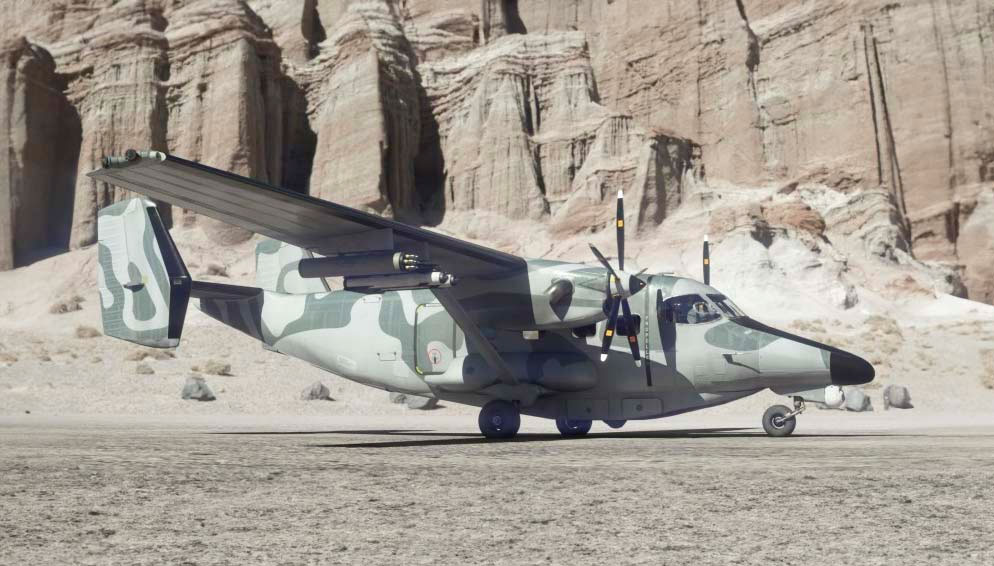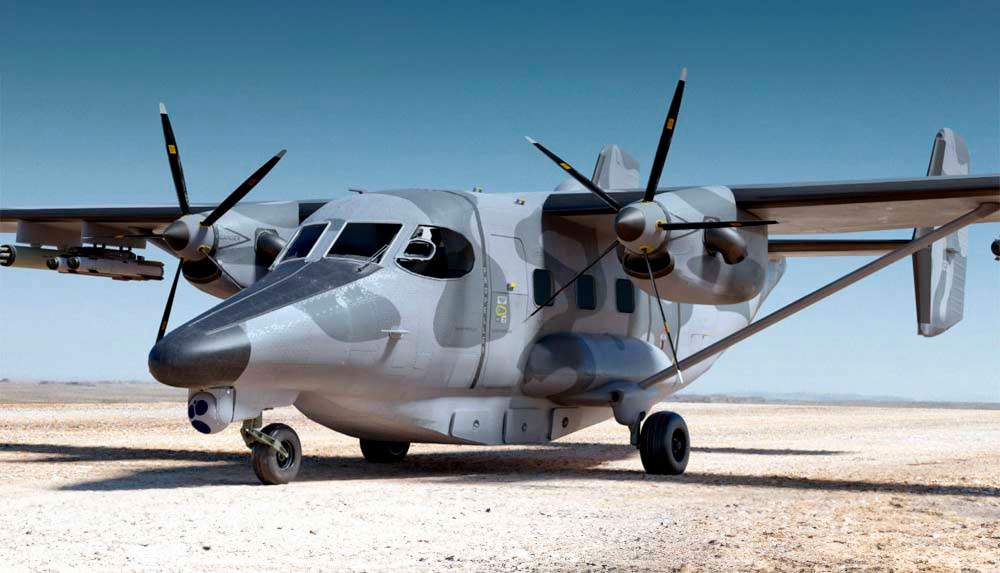The SNC MC-145B Wily Coyote is a multi-role strike aircraft derived from the PZL M28 Skytruck, featuring STOL capabilities and advanced avionics.
The SNC MC-145B Wily Coyote is a multi-role strike aircraft developed by Sierra Nevada Corporation (SNC) in collaboration with PZL Mielec, a Lockheed Martin company. Based on the PZL M28 Skytruck, the MC-145B features short take-off and landing (STOL) capabilities, making it suitable for operations in austere environments. Powered by two Pratt & Whitney PT6A-65B turboprop engines, each producing 1,100 shaft horsepower (820 kW), the aircraft supports a variety of missions, including airdrop, intelligence, surveillance, reconnaissance (ISR), and medical evacuation (medevac). Its modular design allows for rapid reconfiguration to accommodate different payloads and mission requirements. The MC-145B is equipped with advanced avionics and communication systems, enhancing situational awareness and interoperability with other platforms. With a wingspan of 72.38 feet (22 meters) and a length of 43 feet (13.1 meters), it offers a maximum payload capacity of 5,070 pounds (2,300 kilograms) and a range of up to 1,070 nautical miles (1,982 kilometers) when carrying a 2,000-pound (907-kilogram) payload.
History of the Development of the SNC MC-145B Wily Coyote
In the early 21st century, military operations increasingly required aircraft capable of performing multiple roles, especially in austere and unpredictable environments. The need for a versatile platform that could conduct airdrop missions, ISR, and medevac operations became evident. To address this requirement, Sierra Nevada Corporation (SNC), in collaboration with PZL Mielec, initiated the development of the MC-145B Wily Coyote.
The MC-145B is an enhanced version of the PZL M28 Skytruck, a twin-engine turboprop utility aircraft known for its STOL capabilities. The M28 itself was developed from the Soviet-era Antonov An-28 and had seen service in various roles worldwide. Recognizing the potential of the M28 platform, SNC and PZL Mielec sought to create a multi-role aircraft tailored to the needs of special operations forces.
In May 2021, the U.S. Special Operations Command (USSOCOM) launched the Armed Overwatch program, aiming to acquire a new manned light attack aircraft to support special operations forces in permissive environments. SNC and PZL Mielec entered the MC-145B into this competition, highlighting its multi-role capabilities and suitability for diverse mission profiles.
The MC-145B was designed to address specific operational needs identified during conflicts in the Middle East and other regions. These conflicts underscored the importance of having aircraft capable of operating from short and unprepared airstrips, delivering precision strikes, and conducting ISR missions. The MC-145B’s development focused on creating a platform that could be rapidly reconfigured for various missions, reducing the logistical footprint and increasing operational flexibility.
The aircraft’s first flight occurred in 2021, marking a significant milestone in its development. Following its maiden flight, the MC-145B underwent a series of evaluations and demonstrations to showcase its capabilities to potential operators, including USSOCOM. These demonstrations highlighted the aircraft’s ability to perform airdrop missions, conduct ISR operations, and provide close air support with precision-guided munitions.
The name “Wily Coyote” reflects the aircraft’s intended role as a cunning and adaptable platform, capable of performing a variety of missions in challenging environments. The moniker draws inspiration from the resourceful cartoon character, symbolizing the aircraft’s versatility and agility.
Throughout its development, the MC-145B benefited from the combined expertise of SNC and PZL Mielec. SNC brought experience in integrating advanced avionics, communication systems, and mission-specific equipment, while PZL Mielec contributed its knowledge of airframe design and manufacturing. This collaboration resulted in an aircraft that leverages the strengths of both companies to meet the evolving needs of special operations forces.
The MC-145B’s development also considered the importance of interoperability with existing military assets. The aircraft was designed to operate seamlessly with other platforms, sharing data and coordinating missions to enhance overall operational effectiveness. This focus on interoperability ensures that the MC-145B can integrate into joint and coalition operations, providing a force multiplier effect.
As of 2021, the MC-145B was undergoing further testing and evaluation as part of the Armed Overwatch program. The outcome of this program would determine the aircraft’s future role within USSOCOM and its potential adoption by other military forces seeking a versatile and adaptable multi-role platform.

Design of the SNC MC-145B Wily Coyote
- Height: 15.7 feet (4.8 meters)
- Wing Area: 505 square feet (47 square meters)
The MC-145B features a high-wing monoplane configuration, offering excellent visibility for pilots and facilitating cargo and personnel loading. Its durable airframe and STOL (Short Take-Off and Landing) capability enable operations from unprepared airstrips, making it suitable for austere environments.
Powerplant:
The aircraft is powered by two Pratt & Whitney PT6A-65B turboprop engines, each generating 1,100 shaft horsepower (820 kW). These engines provide the thrust necessary for short-field performance and ensure reliable operation in various climates.
Cabin and Payload:
The spacious cabin can be rapidly reconfigured to accommodate different payloads, including:
- Cargo: Up to 5,070 pounds (2,300 kilograms).
- Personnel: Configurable for 19 passengers or mission-specific crews.
- Medical Evacuation: Capable of carrying litters for medevac missions.
The aircraft’s rear cargo ramp simplifies loading and unloading, enhancing operational efficiency.
Avionics and Systems:
The MC-145B is equipped with advanced avionics for enhanced situational awareness, including:
- A digital cockpit with multifunction displays.
- State-of-the-art communication systems for interoperability.
- Precision targeting systems for guided munitions.
Weapons Integration:
The aircraft can carry various precision-guided munitions and external stores on wing-mounted pylons. This includes AGM-114 Hellfire missiles, precision-guided bombs, and other ordnance, making it capable of close air support missions.
STOL Capabilities:
The MC-145B’s rugged landing gear and high-lift wing design enable take-offs and landings on short and unpaved runways. It requires less than 1,800 feet (548 meters) of runway for takeoff with a full payload, emphasizing its adaptability for remote operations.
Advantages:
- Exceptional versatility for diverse missions.
- Capability to operate from remote and unprepared airstrips.
- Cost-effectiveness compared to larger multi-role platforms.
Drawbacks:
- Limited speed and range compared to jet-powered aircraft.
- Payload capacity, while versatile, is constrained compared to larger transport aircraft.
The design of the MC-145B reflects a focus on practical performance in challenging environments, making it a valuable tool for special operations.
Performance of the SNC MC-145B Wily Coyote
The performance specifications of the MC-145B highlight its utility as a multi-role platform designed for efficiency and adaptability.
Engine and Propulsion:
The Pratt & Whitney PT6A-65B engines deliver consistent performance across diverse operating conditions. The engines are optimized for fuel efficiency, providing the aircraft with long-range capabilities while minimizing operational costs.
Speed and Altitude:
- Maximum Speed: 210 knots (389 km/h).
- Cruise Speed: 160 knots (296 km/h).
- Operational Ceiling: 25,000 feet (7,620 meters).
These speed and altitude capabilities make the MC-145B suitable for low- and medium-altitude operations, including ISR and tactical transport missions.
Range and Endurance:
The MC-145B has a range of 1,070 nautical miles (1,982 kilometers) when carrying a 2,000-pound (907-kilogram) payload. With auxiliary fuel tanks, this range can be extended to support longer missions. The endurance of over 6 hours allows for prolonged ISR coverage or extended transport operations.
Payload Versatility:
The aircraft can carry a wide array of payloads, including:
- Precision Munitions: AGM-114 Hellfire missiles and laser-guided bombs.
- ISR Equipment: Electro-optical/infrared (EO/IR) sensors and synthetic aperture radar (SAR).
- Cargo and Troops: 5,070 pounds (2,300 kilograms) of cargo or up to 19 personnel.
Comparison to Competitors:
The MC-145B competes with platforms like the Air Tractor AT-802U and C-146A Wolfhound. While the AT-802U focuses primarily on strike missions, the MC-145B offers greater versatility with its multi-role capabilities. Compared to the C-146A, the MC-145B’s STOL capabilities and modular design provide enhanced operational flexibility.
Operational Efficiency:
The MC-145B is designed for low-intensity conflicts and operations in remote regions. Its STOL capabilities, combined with reliable turboprop engines, make it a cost-effective solution for countries seeking adaptable platforms without significant logistical demands.
Variants of the SNC MC-145B Wily Coyote
The MC-145B program includes potential variants to address specific operational needs:
1. Standard MC-145B:
This baseline configuration includes modular payload bays, advanced avionics, and weapon integration, supporting ISR, transport, and close air support missions.
2. ISR-Dedicated Variant:
Equipped with enhanced EO/IR sensors and SIGINT equipment, this variant focuses on intelligence gathering and surveillance missions. It sacrifices some payload capacity to accommodate additional sensor systems.
3. Medevac Variant:
This version is optimized for medical evacuation, featuring a reconfigured cabin with litter stations and medical support equipment. Its STOL capability allows it to operate close to combat zones or disaster areas.

Military Use and Combat of the SNC MC-145B Wily Coyote
The MC-145B is designed to address operational gaps in austere and permissive environments. Its primary use cases include ISR, precision strike, and tactical transport missions.
Weapons and Armament:
The MC-145B is equipped to carry:
- AGM-114 Hellfire Missiles: For precision strikes against armored targets.
- Laser-Guided Bombs: For tactical air support missions.
- External Gun Pods: Optional for close air support.
Its ability to combine ISR and precision strike roles ensures rapid response capabilities in combat scenarios.
Operational Deployments:
Although relatively new, the MC-145B has undergone demonstrations for USSOCOM’s Armed Overwatch program. Its capability to operate in harsh environments and support special forces missions has been emphasized during evaluations.
International Interest:
The aircraft’s cost-effective operation and versatility make it appealing to nations with limited defense budgets. While no large-scale exports have been confirmed, its adaptability positions it as a competitive option for allied forces requiring multi-role platforms.
Competing Aircraft in Combat Roles:
The MC-145B faces competition from aircraft like the Pilatus PC-12 NGX and Beechcraft AT-6 Wolverine. While these platforms excel in specific roles, the MC-145B’s multi-mission design and STOL capabilities provide unique advantages in dynamic operational settings.
Future Potential:
The MC-145B’s success depends on its performance in USSOCOM’s Armed Overwatch program. If selected, it could become a cornerstone for U.S. special operations and a model for other militaries seeking similar capabilities.
The SNC MC-145B Wily Coyote combines modularity, STOL capabilities, and multi-role functionality to address modern military needs. Its versatility and efficiency make it a valuable platform for ISR, transport, and precision strike missions, particularly in austere environments. While it faces competition from established platforms, its adaptability ensures it remains a strong contender in its class.
Back to the Special Aircraft section